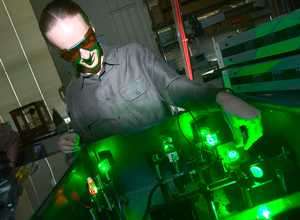Argonne researcher studies what makes quantum dots blink

In order to learn more about the origins of quantum dot blinking, researchers from the U.S. Department of Energy's Argonne National Laboratory, the University of Chicago and the California Institute of Technology have developed a method to characterize it on faster time scales than have previously been accessed.
Nanocrystals of semiconductor material, also known as quantum dots, are being intensively investigated for applications such as light-emitting diodes, solid-state lighting, lasers, and solar cells. They are also already being applied as fluorescent labels for biological imaging, providing several advantages over the molecular dyes typically used, including a wider range of emitted colors and much greater stability.
Quantum dots have great promise as light-emitting materials, because the wavelength, or color, of light that the quantum dots give off can be very widely tuned simply by changing the size of the nanoparticles. If a single dot is observed under a microscope, it can be seen to randomly switch between bright and dark states. This flickering, or blinking, behavior has been widely studied, and it has been found that a single dot can blink off for times that can vary between microseconds and several minutes. The causes of the blinking, though, remain the subject of intense study.
The methods developed by Matt Pelton of Argonne's Center for Nanoscale Materials and his team of collaborators has revealed a previously unobserved change in the blinking behavior on time scales less than a few microseconds. This observation is consistent with the predictions of a model for quantum-dot blinking previously developed by Nobel Laureate Rudolph Marcus, contributor to this research, and his co-workers. In this model, the blinking is controlled by the random fluctuation of energy levels in the quantum dot relative to the energies of trap states on the surface of the nanocrystal or in the nearby environment.
The results of this research provide new insight into the mechanism of quantum-dot blinking, and should help in the development of methods to control and suppress blinking. Detailed results of this work have been published in a paper in the Proceedings of the National Academy of Sciences.
Source: Argonne National Laboratory




















